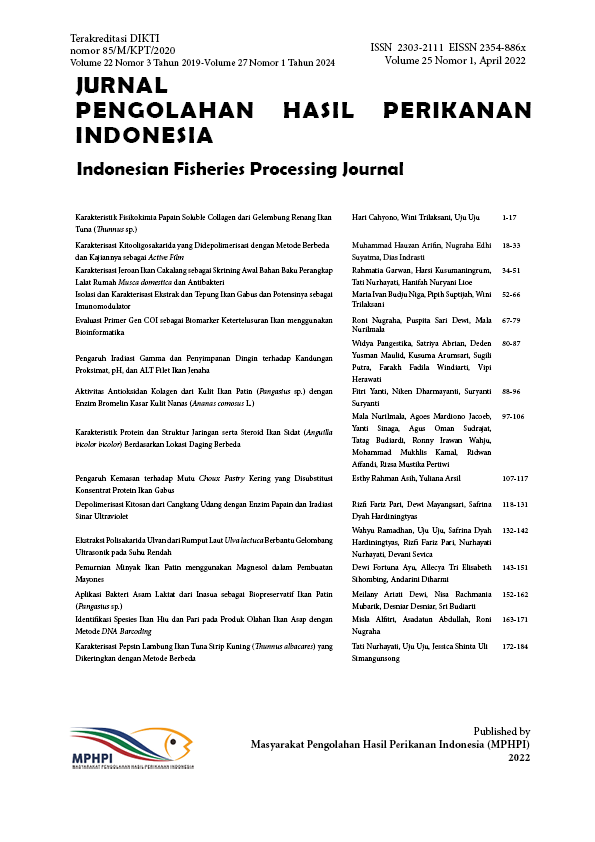Identifikasi Spesies Ikan Hiu dan Pari pada Produk Olahan Ikan Asap dengan Metode DNA Barcoding Identification of Shark and Sting Fish Species in Smoked Fish Processed Products Using The DNA Barcoding Method
Abstract
Sharks and rays are a group of fish whose trade is regulated both locally and internationally. The high demand for shark products in the market can result in the scarcity of certain shark species in the wild. Authentication on processed shark products is needed to detect the type of shark species used in a product. The purpose of this study was to identify species of sharks and rays in processed smoked products originating from the PANTURA, Tegal Jawa Tengah using the DNA barcoding method. The research method consisted of sample collection, DNA isolation, DNA extraction, DNA concentration and purity, PCR amplification and sequencing, Electrophoresis, Sanger Sequencing, PCR testing with COI molecular marker, and analysis of bioinformatics data. Species identification results from processed products of stingrays and smoked sharks were detected using sharks, including Carcharhinus brevipinna, Telatrygon zugei, Rhizoprionodon oligolinx, Himantura uarnacoides, Maculabatis macrura, Hydrolagus novaezealandiae, and Rhynchobatus australiae. Rhynchobatus australiae and Carcharhinus brevipinna are species listed as a protected shark in CITES II. The sequences obtained have a similarity percentage between 99.84-100% with the sequences found in GenBank.
References
Abdullah A, Nurilmala M, Sari AS, Jacoeb AM. 2018. Mini-coi barcodes sebagai penanda molekuler untuk ketertelusuran label pangan berbagai produk olahan ikan sidat. Jurnal Pengolahan Hasil Perikanan Indonesia. 21(2):377-384.
Abdullah A, Rehbein H. 2017. DNA barcoding for the species identification of commercially important fishery products in Indonesian markets. International Journal of Food Science & Technology. 52(1):266–274.
Bräutigam A, Callow M, Campbell IR, Camhi MD, Cornish AS, Dulvy NK, Fordham SV, Fowler SL, Hood AR, McClennen C, Reuter EL, Sant G, Simpfendorfer CA, Welch DJ. 2015. Global Priorities for Conserving Sharks and Rays: A 2015–2025 Strategy. San Jose (CR): Copa.
Dharmadi, Fahmi, Triharyuni S. 2012. Aspek biologi dan fluktuasi hasil tangkapan cucut tikusan, (Alopias pelagicus) di Samudera Hindia. Bawal. 4:131-139.
Dudgeon CL, Blower DC, Broderick D, Giles JL, Holmes BJ, Kashiwagi T, Krück NC, Morgan JAT, Tillett BJ, Ovenden JR. 2012. A review of the application of molecular genetics for fisheries management and conservation of sharks and rays. Journal of Fish Biology. 80(5):1789–1843.
Dudgeon CL, Blower DC, Broderick D, Giles JL, Holmes BJ, Kashiwagi T, Krück NC, Morgan JAT, Tillett BJ, Ovenden JR. 2012. A review of the application of molecular genetics for fisheries management and conservation of sharks and rays. Journal of Fish Biology. 80(5):1789–1843.
Hanner RH, Naaum AM, Shivji MS. 2016. Conclusion: DNA-Based Authentication of Shark Products and Implications for Conservation and Management. Elsevier Inc.
Hellberg RS, Isaacs RB, Hernandez EL. 2019. Identification of shark species in commercial products using DNA barcoding. Fisheries Research. 210 2:81–88.
Hobbs CAD, Potts RWA, Bjerregaard Walsh M, Usher J, Griffiths AM. 2019. Using DNA barcoding to investigate patterns of species utilisation in UK shark products reveals threatened species on sale. Scientific Reports. 9(1):1–10.
Kappel K, Haase I, Käppel C, Sotelo CG, Schröder U. 2017. Species identification in mixed tuna samples with next-generation sequencing targeting two short cytochrome b gene fragments. Food Chemistry. 234:212–219.
Kimura M. 1980. A simple method for estimating evolutionary rate of base substitutions through comparative studies of nucleotide sequences. Journal of Molecular Evolution. 16(2):111- 120.
Labrador K, Agmata A, Palermo JD, Follante J, Pante MJ. 2019. Authentication of processed Philippine sardine products using Hotshot DNA extraction and minibarcode amplification. Food Control. 98:150–155.
Marshall LJ, Barone M. 2016. SharkFin Guide: identifying sharks from their fins.
Muttaqin, Simeon BM, Ichsan M, Agustina S, Prasetyo AP, Dharmadi, Yulianto I. (2019). Laporan Teknis: Profil Perikanan Wedgefish di Indonesia, Studi Kasus di Nusa Tenggara Barat dan Aceh. Bogor: Wildlife Conservation Society Indonesia.
Paracchini V, Petrillo M, Lievens A, Kagkli DM, Angers-Loustau A. 2019. Nuclear DNA barcodes for cod identification in mildly-treated and processed food products. Food Addit Contam - Part A Chem Anal Control Expo Risk Assess. 36(1):1–14.
Qiu J, Shen B, Zhao M, Wang Z, Xie B, Xu Y. (2020). A nationwide survey of psychological distress among Chinese people in the COVID-19 epidemic: implications andpolicy recommendations. General Psychiatry. 020 Mar 6;33(2):e100213.
Rodrigues-Filho LF, Pinhal D, Sodré D, Vallinoto M. 2012. Shark DNA Forensics: Applications and Impacts on Genetic Diversity. Di dalam Analysis of Genetic Variation in Animals.Intech Open.
Sahaba MAB, Abdullah A, Nugraha R. 2021. DNA barcoding untuk autentikasi produk hiu segar dari perairan Nusa Tenggara Barat. Jurnal Pengolahan Hasil Perikanan Indonesia. 24(3):407-414.
Thresher Shark Indonesia. 2020. Pemasangan Internal Acoustic Tag pada Hiu Tikus Menjadi yang Pertama di Indonesia dan Dunia. https://threshershark.id/id/update/internal-acoustic-tag-hiu-tikus/
Triani N. 2020. Isolasi DNA tanaman jeruk dengan menggunakan METODE CTAB (Cetyl Trimethyl Ammonium Bromide). Jurnal Teknologi Terapan. 3(2): 14-19.
Wardani AK, Arlisyah A, Fauziah A, Fa’ida TN. 2017. Identifikasi gen transgenik pada produk susu bubuk kedelai dan susu formula soya dengan metode PCR (Polymerase Chain Reaction). AGRITECH. 37(3):237–245.
Wibowo S, Susanto H. 2005. Sumber daya dan Pemanfaatan Hiu. Jakarta: Penebar Swadaya.
Wong EH, Hanner RH. 2008. DNA barcoding detects market substitution in North American seafood. Food Research International. 41:828-837.
Authors

This work is licensed under a Creative Commons Attribution 4.0 International License.
Authors who publish with this journal agree to the following terms:
- Authors retain copyright and grant the journal right of first publication with the work simultaneously licensed under a Creative Commons Attribution License that allows others to share the work with an acknowledgement of the work's authorship and initial publication in this journal.
- Authors are able to enter into separate, additional contractual arrangements for the non-exclusive distribution of the journal's published version of the work (e.g., post it to an institutional repository or publish it in a book), with an acknowledgement of its initial publication in this journal.





